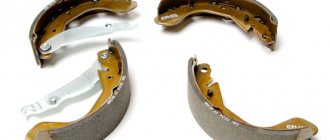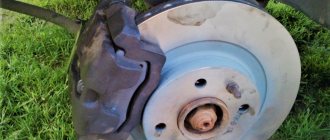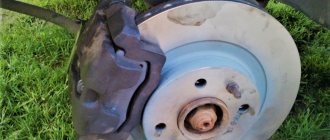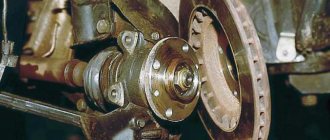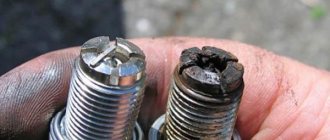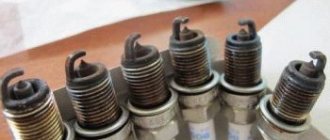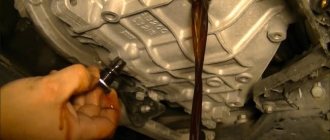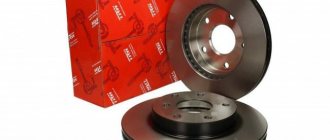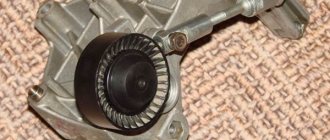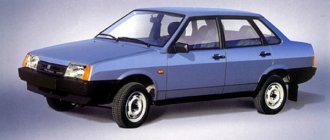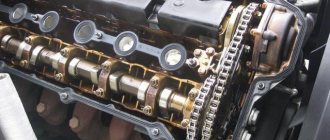The topic of our material today will be the replacement of brake pads, signs of their malfunctions and types of these elements. I hope you find it interesting and useful.
Even as a young man who first received an old Zhiguli from his father, it didn’t matter to me what kind of car it was, what year it was made or how much horsepower there was under the hood.
Dad put forward the condition that once the car was transferred to me, it would be at my complete disposal and under my responsibility. In other words, if you love to ride, you also love to repair Zhiguli.
Every driver should understand that the main thing is not to accelerate, but to be able to brake in time. VAZ, Nissan, Chevrolet, Toyota, Opel, Mazda or Skoda cars can accelerate from 20 to 100 kilometers per hour in 20 seconds, or spend literally a few seconds doing so. If everything is fine with the brakes, there will be no problems, it will not be difficult to reduce the speed to zero.
But the brake system, like many other automotive components, wears out over time and fails. Usually this happens gradually and only in special situations can a breakdown occur without preliminary symptoms of a problem. Therefore, I suggest you discuss such a topic as replacing brake pads and consider what indicates the need for replacement, when it is necessary to change and which elements are best to choose.
Operational Factors
Some drivers carry out the replacement after 50...60 thousand km, while for others the deadline comes already at 10...15 thousand km . The main factors in this situation are the method of operation, driving style, pad manufacturer and type of brake system.
It is also worth paying attention to the accompanying elements of the system, the condition of which determines how long it takes to change the brake pads:
- adjusting rods with fasteners;
- various seals and protective boots;
- cuffs and hydraulic hoses;
- damping springs or fixing brackets.
The wear of these components also leads to rapid wear of the friction linings.
The quality and design of brake discs or drums has a direct impact on the overall performance of the brakes. Ventilated discs from well-known manufacturers will last much longer due to optimal conditions, and the mileage of the pads with them will increase.
When diagnosing the brake system, it is worth checking that the caliper is installed correctly. Its misalignment affects the uniform wear of the pads. This property also affects braking efficiency. This phenomenon can be noticed by the unevenly wiped lining.
Negative external factors include the following phenomena:
- temperature regime;
- the presence of aggressive reagents and salts.
These circumstances can shorten the service life of products, since the main friction elements lose the physical and chemical parameters specified by the manufacturer.
It is recommended to replace the pads for all wheels at the same time . This will ensure high-quality operation of the system.
How to make the right choice?
So, the decision about the need for replacement has been made. But how to choose brake pads? One of the main parameters when choosing such a product is the operating temperature of the device.
On average, this indicator should be in the range from 300 to 350 degrees Celsius. For VAZ cars, this indicator is sufficient. Adherents of sports driving or drivers who live in mountainous areas are better off giving preference to more “hardy” pads with an operating temperature of about 800 degrees Celsius.
Other reasons for replacing pads
In addition to situations with critical wear, it is necessary to change brake pads in the following cases:
- the thickness of the friction material is more than 5 mm, but the lining itself has begun to peel off from the steel base;
- cracks and chips appeared on the surface, the material began to crumble;
- stains of oil or brake fluid that reduce friction properties were found on the parts;
- when the brake drum or disc is replaced.
Another reason for replacement is due to the abundance of low-quality fakes on the automotive spare parts market . New pads purchased from an unreliable retail outlet begin to squeak or squeak terribly after 1-2 thousand km, although the working part is still far from completely worn out. The culprit is the material of the part, whose hardness is comparable to metal, causing the surface to “slick” and create a creaking sound. If the elements made from unknown materials are not replaced, then the production on the brake discs will increase sharply.
We recommend: Changing the coolant on the VAZ 2114 model
Many modern cars are equipped with special sensors that detect a decrease in the thickness of the friction layer and send a signal to the driver when it reaches a critical level. This is also a reason to remove parts with worn linings and install new ones.
True, the sensors often become clogged with dirt and lose their functionality, so it wouldn’t hurt for the car owner to check the condition of the brakes himself.
Types of friction coating of pads
The main working material responsible for the process of stopping a car is a friction layer attached to the metal part of the block. The ideal combination of materials used in their production has not yet been achieved. There are currently four types of brake bars produced:
- Pads with a semi-metallic friction layer applied to them, in which up to 65% of the components are copper, steel wire or iron powder, mixed with graphite for better friction. Their advantage is high heat transfer, and their disadvantages are rapid wear and noise.
- Planks with material glued to them from organic components: high-temperature resin, rubber, glass, Kevlar and carbon. Their positive qualities include less noisy operation and softness, while their negative qualities include a shorter service life and a sufficient amount of dust emitted by them.
- Pads with a small content of metal elements, no more than 30%, with the addition of organic substances (described above). This contributes to good heat transfer, but affects their noise.
- Ceramic planks are currently considered the best option. Their friction layer is made of ceramic fibers with the addition of a filler that includes a small amount of copper. Being lightweight, these pads are more durable in operation and produce less noise.
How to know when it's time to change your brake pads
You can determine that the TCs are worn out by the following signs:
- when braking, an unpleasant metallic grinding sound is heard;
- when you press the brake pedal, you feel a beating in the steering wheel;
- braking efficiency has decreased, braking distance has increased;
- The brake pedal has increased free play, it goes right to the floor, and in some cases you have to press the pedal twice.
Novice motorists often ask the question: what happens if you drive with worn out pads? In case of large wear of the TC:
- brake discs and drums wear out intensively;
- if there are very few linings left, the brake cylinders may leak;
- The brakes completely disappear, and then an emergency situation arises.
How to determine the degree of pad wear
One of the signs that the pads are worn out is a characteristic squeaking sound when braking. The wear sensor starts making this sound. It is a special plate. When the friction material of the pads is worn away, the plate begins to touch the disc and the sensor is activated.
There is another type of sensor. On some vehicles, the wear sensor is a metal contact that is inserted deep into the brake pad. When the pad wears out, the contact comes into contact with the disc, outputting a light signal to the panel.
If there is no wear sensor, then the need for replacement arises when the thickness of the friction material of the pads reaches 1-1.5 mm (excluding the thickness of the metal base).
Sometimes it happens that the pad wears unevenly. Or it happens that the grooves on one block are completely erased, but not on the other. As a rule, this indicates that the caliper is not working properly. In this case, simultaneously with replacing the pads, it is necessary to repair the caliper.
Another indicator of pad wear is the brake fluid level. When the pads wear down, the brake caliper pistons move towards the disc. This means that fluid consumption increases.
Also, the following factors can indirectly indicate pad wear: decreased braking efficiency (especially during emergency braking), increased brake pedal travel, etc.
Cracks and various damages on them also indicate that the pads need to be replaced.
When replacement is required
To begin with, let me remind you that the block consists of two main components. This is the lining (aka friction) and the body itself. It is the friction element that performs the most important function, that is, it brakes the brake disc. Therefore, it gradually wears out naturally. Replacing the pad is only a matter of time. Previously, they only changed the linings themselves, but now they simply dismantle the entire block and put a new one in its place.
When exactly it will be necessary to replace disc brakes or change the drum, no one can say for sure. Wear and performance depend on a number of factors:
- original quality of the pads;
- driving style;
- conditions and features of vehicle operation;
- intensity of pressing the brake pedal;
- quality of roads;
- model and condition of the car itself, etc.
If we talk about the pads on the front wheels of a car, they can last approximately 10-15 thousand kilometers. This is a completely normal indicator for an average car in our conditions (road quality, weather, etc.).
And the pads installed on the rear wheels last longer, since the load on them is slightly less. This is if the main load in the car falls on the front brakes, and not the rear. They usually live 30-60 thousand kilometers, and sometimes more.
Installing rear disc brakes is a popular modification for a car because they are more efficient and reliable. Some cars are already equipped with disc brakes. Therefore, when buying a Ford Focus, Renault Logan, Hyundai Solaris, Volkswagen Polo or Passat, Kia or Audi cars, pay attention to how the brake system is designed on them and what it consists of.
There is one general rule for everyone. Brake pads should not be worn more than 1.5 millimeters from their original size. If wear exceeds one and a half millimeters, this will negatively affect the quality of braking, and you risk damaging other components of the system. Plus, the car will start making unpleasant sounds that will literally irritate you every time you press the brake pedal. There is no need to think about what to lubricate or where to turn the wrenches, as long as the creaking goes away. An unusual sound is a clear sign of wear. You will lubricate new components of the brake system during the replacement process.
Now there are so-called smart pads. Their peculiarity is that they have a wear indicator. When the time for replacement comes, that is, the block is ground down to the maximum permissible value, a characteristic squeak appears. From it, the driver easily understands that it is time to change this device, otherwise trouble will not be avoided.
We recommend: What should be the tire pressure of a car?
Characteristic signs of wear
Yes, you can periodically send your car to a car service center, of which there are a huge number in the cities of St. Petersburg, Moscow and many others. But before going to the service station, you should understand why such measures and diagnostics were needed in the first place.
Some evaluate the current state of the elements with their own hands. Moreover, self-diagnosis looks quite simple:
- the front wheels are removed one by one and the condition of the pads is checked;
- if the thickness is below the acceptable level, it’s time to change;
- on the rear wheels, the drum is additionally removed to measure the thickness of the pad;
- the disk is cleaned of dust and dirt;
- measurements are taken using a caliper;
- The thickness of the brake disc must be at least 10.8 mm;
- If the pad is worn out only on the left or right, it still needs to be replaced in pairs.
Also, during dismantling, you can find several additional signs of problems:
- the surface is contaminated with oil;
- when braking there is a strong creaking, grinding sound;
- the block is poorly connected to the base;
- When you press the brake pedal, you feel a blow to it.
In general, I strongly recommend that all drivers pay attention to the behavior of their car, the condition of certain consumables and more. With a few simple tips, you will be able to detect in time that the life of the pads is coming to an end and you will soon have to change them.
- Brake fluid. It is located in a special tank, and therefore its level can be constantly monitored. If the level drops, this indicates wear on the pads or the brake discs themselves.
- Brake pedal. It happens that the pedal falls through or when you press it you feel a beating. In the first case, check the presence of brake fluid and the condition of the pad itself. But the beating, which occurs mainly during sudden braking, can occur due to uneven natural wear of the disc or pad. Plus, be sure to visit a service station or check the brake system yourself if pressing the pedal is different from usual - it becomes tighter, sharper, lighter, etc.
- Dust. We are talking about friction dust, that is, particles of a washable lining. If there are traces of brake dust on the pads with the addition of metal shavings, then this is very bad. Adding to this a symptom such as grinding, most likely there are problems with the entire brake system. It is not recommended to operate the machine until repaired.
- Sensor. Some cars have a special wear indicator for your pads. It works extremely simply, since it is built into the friction lining and is made of soft metal. When the wear is critical, the circuit closes and a warning icon appears on the dashboard, indicating the need to urgently replace the pads.
But I wouldn’t advise you to rely entirely on the sensor. It is in constant harmful contact with moisture, dirt and water, which is why it may not work or provide erroneous data.
Replacement dates and signs
Based on the model of the brake mechanism and the friction material of the bars, manufacturers indicate how many thousands of kilometers the pads can last. Manufacturers also recommend when it is necessary to change the strips, focusing on the remaining minimum permissible friction layer.
All this is described in the instructions for the car, but there are average standards, the value of which ranges from 20 to 30 thousand km, for the front slats in disc brakes. And for drum and disc type rear brake pads, this mileage interval in km must be multiplied by two.
The weight of the machine also plays a big role in the wear rate. The above figures are relevant for small passenger cars weighing up to 1300 kg. If we consider large sedans weighing about 1600 kg, then the wear of the bars will occur one and a half times faster. For cars with a curb weight of 1800 kg or more, the pads will need to be replaced after they have covered a distance half as much as a small passenger car can travel.
If the car was bought used, there is often no way to find out when the pads were last changed and what their mileage was. Some signs will help you understand that it’s time to replace them:
- The pad wear warning light on the instrument panel came on. Some brake pads have an electronic or mechanical indicator that signals when the friction material has worn down to the minimum limit and it is time to replace them.
- There was a sound when the car stopped. This sound occurs at a certain percentage of wear of the friction material, when it is worn down to metal.
- When stopping suddenly, a sound is heard and a beating is felt in the area of the wheels. The reason for this is uneven wear of the pads or cracks and chips that may occur on the disc or friction layer. In this case, even the indicator, if present, may not work. Uneven wear of the friction layer is dangerous because after a certain number of kilometers you will have to change not only the strips, but also the wheel disk or drum.
Signs of wear
The driver can learn about the degree of wear of the pads by indirect signs. It is only necessary to correctly interpret these signals. One of the main symptoms is an increase in braking distance, as well as a violation of straightness during braking. Negative factors include an extended pedal stroke and a noticeable decrease in its rigidity.
The car owner should check the condition of the linings during intermittent locking during braking. This occurs after abrasion of rubber, resins and other inclusions, after which frictional interaction of the metal elements of the pad with the brake disc occurs.
Wear creates the appearance of wheel runout when braking. Creaks, rattles and other extraneous noises appear. This behavior can lead to jamming of the pads and complete blocking of the wheel, which will have a devastating effect on the entire assembly.
Modern cars are equipped with specialized pad condition sensors . Once the pad drops to a critical size, the driver receives a corresponding notification. Mechanical devices will make squeaking noises. For electronic monitoring units, a light signal is provided on the instrument panel. The light comes on every time the ignition is turned on.
We recommend: Pressure in the car air conditioner - how to know that everything is normal?
Also, some manufacturers apply special control grooves, and when the lining wears off to such an extent that the grooves disappear, it needs to be changed. It is undesirable to bring the pads to a state in which the lining decreases below 2...3 mm .
Which pads should I buy?
Some car enthusiasts, wanting to save money, follow the lead of car market sellers, who advise purchasing non-original pads, but “quite suitable for the car.” It is better not to buy such pads. The pads interact directly with the brake discs. The disc and pad material must be compatible. Otherwise, there will be no braking effect itself, and in addition to this, due to the incompatibility of materials, a constant grinding and whistling noise will be heard during braking.
In addition to everything, non-original pads can bend the brake discs, so you will have to do a thorough repair.
Manufacturers' recommendations
The brake pad consists of a base made of thick metal with a lining made of friction material attached to it. Its components are rubber, graphite and mineral fibers bonded with technological resins. How often to change these important parts for safe driving is indicated in the car's operating instructions. Typically, passenger car manufacturers recommend observing the following intervals between replacements:
- on cars of post-Soviet countries, it is planned to install new parts after 10-15 thousand kilometers;
- on foreign cars, whose spare parts are traditionally of higher quality, the interval is from 15 to 25 thousand km;
- a separate category is powerful sports cars, where replacement is carried out every 5-10 thousand km.
Practice shows that the front brake pads experience greater loads than the rear ones, which is why they wear out faster.
Russian car enthusiasts should not rely entirely on the recommendations in the technical data sheet, since the wear of the linings is influenced by many factors:
- The more aggressive the driving style, the faster the working surfaces wear out, because on 1 km of travel you use the brakes twice as often as the average driver.
- Operating conditions of the machine. If you constantly drive on unpaved and poor roads, then wear accelerates due to dirt getting on the brake discs and drums.
- The quality of the material from which the part is made.
- Technical condition of brake drums and discs. When grooves appear on the surfaces of these elements, the linings wear out much faster.
- Constant transportation of goods.
This raises the question of how long brake pads last in real life. The mileage range is quite wide - from 5 to 45 thousand km, depending on the brand of car and the degree of influence of these factors. That is why it is important to independently monitor the condition of the linings.
How to determine brake disc wear?
Brake discs wear out more slowly than pads. As a rule, replacing discs coincides with the second change of pads.
The following factors indicate wear of the brake discs: disc thickness less than 11 mm and abrasions on the surface of the disc. It is because of these abrasions that braking efficiency is reduced and the brake pads wear out much faster. Also, when the discs wear out, noise and beating are felt, and when you press the pedal, the brakes lock.
Pads from different manufacturers (some softer, others harder) cause different wear on brake discs. This is due to the composition of the mixture from which the pads are made.
You can determine the degree of disc wear using a caliper. The result obtained must be checked against the acceptable data for a specific model. They are indicated in the car's operating manual.
The effectiveness of the braking system directly depends on the condition of the brake pads and discs. There is no set time for replacing them. It is necessary to monitor the condition of the discs and pads. After all, changing them too early is impractical, and being late with a replacement is fraught with negative consequences (for example, caliper breakdown). Therefore, you need to periodically inspect the brake pads and discs to find out if there are any cracks or other damage. You also need to listen to the sounds that the pads make when braking.
Brake disc with pads.
